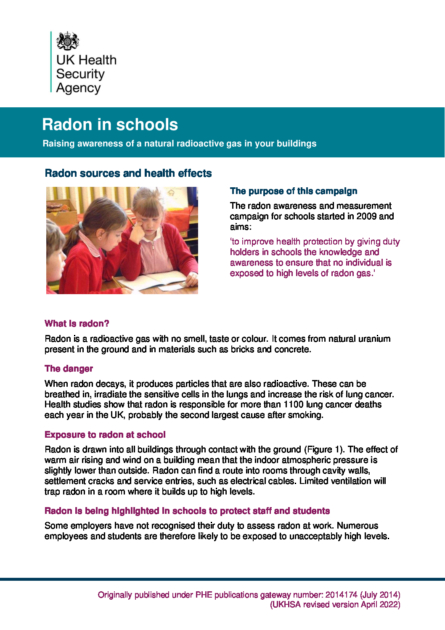Radon in Schools
Radon Risk Assessments for Nurseries, Schools Academy Trusts and Local Authorities
Radon in Schools, Academy Trusts and Local Authority Buildings
While most buildings contain some level of radon, these levels are usually low and do not pose a significant risk to health. However, regions such as Bristol, Wales, Cumbria, and parts of the Peak District have been identified as radon-affected areas, meaning radon levels in buildings, including schools, may be elevated and require monitoring.
In educational settings, the responsibility for managing radon risks falls under The Management of Health and Safety at Work Regulations 1999. This legislation requires employers, including schools, academies, and universities, to assess health and safety risks, including radon exposure, for both staff and students. Schools located in radon-affected areas or those with occupied basements should conduct radon risk assessments to ensure the safety of everyone on site. Universities must also ensure that their student accommodation is assessed for radon risks.
To ensure compliance and protect public health, schools and universities must take proactive steps to assess and mitigate radon risks in their buildings.
You need to make sure that you have completed a radon risk assessment. This includes all schools, universities, and education providers.
Earth Environmental & Geotechnical has experience and expertise in providing full Radon Risk Assessments, Monitoring, and Mitigation for Schools, Academy Trusts and Local Authority Buildings.
What is Radon and Why do schools need to know their Radon Risk?
Radon, a naturally occurring radioactive gas, is produced by the breakdown of uranium in rocks and soil. It is invisible, odorless, and can seep into buildings, including schools, where it may accumulate to harmful levels. Prolonged exposure to radon increases the risk of developing lung cancer, making it a significant public health concern.
In the UK, schools, along with other workplaces, have legal responsibilities to assess and manage radon risks under the Health and Safety at Work Act 1974 and the Management of Health and Safety at Work Regulations 1999. Employers, including school administrators, must conduct radon risk assessments, particularly in radon-affected areas and in buildings with ground floors or basements that are regularly occupied. If radon levels exceed 300 Bq/m³, the Ionising Radiations Regulations 2017 mandate action to reduce radon exposure to protect staff, students, and visitors.
Schools are required to monitor radon levels, especially if they are located in regions with a high likelihood of radon presence. Testing involves placing passive detectors in areas of concern, and if levels exceed safe thresholds, remediation measures such as improved ventilation or sub-slab depressurization systems may be needed. Regular radon monitoring and appropriate mitigation steps are essential to ensure ongoing compliance and safety.
Earth Environmental & Geotechnical Ltd provides comprehensive radon risk assessment services to schools, academy trusts, and local authorities across the UK. They offer testing services, analysis of radon levels, and expert advice on mitigation strategies tailored to each school’s specific needs. This helps institutions not only to meet legal requirements but also to safeguard the health of students and staff by minimizing radon exposure risks.
By proactively assessing and managing radon risks, schools can create safer learning environments while staying compliant with UK health and safety regulations. For detailed radon surveys and tailored advice, contact Earth Environmental & Geotechnical Ltd to assist your school or Academy Trust in mitigating these risks effectively.
For more information on radon risks in schools, you can visit HSE’s radon guide
We can provide a full service of Radon Surveys, Radon Risk Assessments and Radon Mitigation for all Radon Risk Areas.
But How Do You Know if Your School Building, Land, or Grounds Has Higher Levels of Radon?
If you have identified that your school or Academy Trust is in a high risk area, how do you identify the specific radon risk?
Earth Environmental & Geotechnical work with Local Authorities, Property developers, housing associations, schools, and employers to help identify the radon risk for your property or building development. We provide a comprehensive range of Radon Survey, Detection, and Monitoring Services.
Including using MARKUS 10 instruments that allows for in-situ measurement of radon gas in soils. The Markus 10 can provide a clear understanding of the radon levels in the soil of your School site and can quickly allow for an informed decision on whether the site requires radon mitigation measures.
For further information on radon monitoring and detection for School buildings please contact Earth Environmental & Geotechnical now
Don’t Forget your Radon Risk Assessments for Schools & Academy Trust should always include any basement that is occupied. Testing must be carried out if your school or occupied area of ypur buildings has a basement or cellar, regardless of geographic location.
Check Your Postcode Now
How To Safeguard Your School or Academy Trust Against Radon:
Step 1 – Check – is your School or Academy Trust in a Risk Area? Enter your school or Academy Trust Post Code/s.
Don’t forget to click the SHOW RADON DATA red button on the left-hand side.
Step 2 – Measure – if your School or Academy Trust buildings are in a Radon Risk Area you need to take Radon Measurements
Step 3 – Act – If your result is at or above the UK Action Level of 300 Bq m-3
You can find out more information here
Don’t Forget your Radon Risk Assessments for Schools & Academy Trust should always include any basement that is occupied. Testing must be carried out if your school or Academy Trust has a basement or cellar, regardless of geographic location.
Radon Map for Great Britain
Radon Risk Assessments for Academy Trusts, Schools and Local Authorities.
Actions for Schools in Radon Risk Areas
Employers in should carry out three–month radon measurements in the premises for which they are responsible, which have been identified as being in radon “Affected Area”. Even with radon potential maps, no one can predict the radon level in an individual building, so the only way to know for sure is to place a number of small radon monitors throughout the school.
The Government has produced documentation regarding Radon in schools – Raising awareness of a natural radioactive gas in your buildings. The purpose of this “Radon Awareness and Measurement” campaign for schools is ‘to improve health protection by giving duty holders in schools the knowledge and awareness to ensure that no individual is exposed to high levels of radon gas.
It is the responsibility of all Academy Trusts, schools and local authorities to ensure that you know if your school or education provider is in a Radon affected area
The UK Health Security Agency (UKHSA) and the British Geological Survey (BGS) released an updated radon potential map for Great Britain in December 2022, marking the first update in over a decade. This new map offers a refined assessment of areas more likely to have elevated radon levels, known as radon Affected Areas, and helps individuals and employers identify if radon testing is necessary in their homes or workplaces.
Despite radon being a significant contributor to lung cancer deaths—particularly among smokers and ex-smokers—the overall risk for the majority of the population remains low. Most buildings in the UK are not located in high-risk areas. However, some postcodes have been newly classified as high risk, and residents or employers in these regions are encouraged to check the map and consider testing.
The updated map combines advanced geological data and one of the largest collections of in-home radon measurements, providing a more detailed understanding of radon risk. It is a vital tool for local authorities, homeowners, landlords, and businesses, and is also used to inform building regulations, ensuring radon preventative measures are implemented where needed.
You can view the latest map and check your area’s radon risk at UKradon.org.







